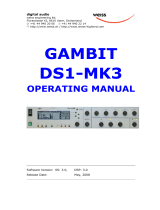Page is loading ...

AR8200 Mk3 hand portable radio receiver ADDENDUM (paperwork V1.0)
Due to continuous development of our products, the AR8200 has evolved into the Mk2 and Mk3 versions. As a result, operation
differs from the original AR8200 in a few areas, please note the following changes to the AR8200 operating manual:
1 The front ‘ten-key’ keypad has been rearranged in line with customer requests placing the ‘0’ zero key underneath the
‘8’ eight key, as is standard practice with push button telephones. On page 9 section 1-5-1 of the English language operating
manual, the graphic should now look like (the revised keypad has been used on the Mk3 and Mk2 versions):
2 The Mk3 and Mk2 versions feature a built-in TCXO (Temperature Controlled Crystal Oscillator) in place of the reference
crystal. This ensures the best levels of frequency stability and minimum spurii.
3 In place of the previous rubber covered aerial, a telescopic whip on a swivel base is supplied (Mk3 and Mk2 versions).
The whip provides the very best performance, especially on the VHF bands with the ability to adjust the length of the telescopic
whip aerial to ‘peak’ received signal strength (the higher the frequency, the shorter the aerial). An alternative flexible smaller
whip aerial is available as an option where durability and smaller size is important. Please refer to page 7 section 1-4 of the
English language operating manual, line two of the table should now read “telescopic whip aerial”.
4 The relationship between level squelch and signal meter has been revised. This affects VFO SEARCH LEVEL SQUELCH
(page 47 section 4-4-3 of the English language operating manual), SCAN LEVEL SQUELCH (page 68 section 7-8-2 of the
English language operating manual) and PROGRAM SEARCH LEVEL SQUELCH (page 84 section 8-7-2 of the English
language operating manual).
In each case, the following table replaces that previously employed:
1 2 3 4 5 6 7 8 9 10 11 12 13 14
Mk2 8 13 18 24 29 35 39 44 50 55 58 62 71 77
Mk3 7 15 18 24 28 31 42 50 59 64 72 80 85 89
As a result, the typical level at which the “«” legend will be extinguished has changed.
5 The batteries supplied with the AR8200 have been changed. To ensure that a completely full charge is established, please
assume the full charge time as follows, this replaces the reference given on page 19 section 1-6-4 of the English language
operating manual.
AR8200 NiCads, 700mAhr 12 hour charge
Mk2 NiCads, 1000mAhr 14 hour charge
Mk3 NiMH, 1500mAhr 22 hour charge
SEE OVER >>>
®
AOR LTD, 2-6-4 Misuji, Taito-Ku, Tokyo 111-0055, Japan Tel: +81 3 3865 1695 Fax: +81 3 3865 1697
e-mail: [email protected] web: www.aorja.com

The AR8200 receiver employs standard ‘AA’ size batteries, so a range of different types can be used (NiCad, NiMH, alkaline
etc). For this reason, the charging circuit cannot be optimised for any one specific type. It is most important that you do not
over-charge the batteries and do not keep topping them up without first running them down. If the batteries are flat, do not
attempt to ‘charge and operate’ the radio for the first hour of charging, this would lead to an increase in internal heat generated
by the AR8200. Do not connect an external power supply, mobile power lead or charger if dry / alkaline batteries are fitted.
In order to provide the optimum level of charge and life-span from the MiMH batteries (Nickel Metal Hydride) supplied with the
Mk3, use of a specialist dedicated external battery charger is recommended, they are readily available from electrical
suppliers. The AR8200 is not designed to charge rechargeable alkaline batteries.
6 The design of the battery compartment and compartment cover has been revised to assist the easy replacement of batteries
(Mk3 and Mk2), refer to page 16 section 1-6-1 of the English language operating manual. The cabinet colour of the AR8200
was green, the Mk3 and Mk2 cabinet is black.
7 The operation of LCD/keypad illumination has been revised in the Mk3 version, refer to page 106 section 14-2 of the English
language operating manual. When operating from internal batteries with AUTO LAMP selected, the illumination will activate for
a few seconds when the squelch first opens. This is very useful for identifying transmission at night-time without using up
excessive power from the batteries.
8 The frequency coverage of the Mk3 version has been extended to 3GHz, the specified range is now 530kHz to 3GHz with
actual minimum frequency input of 100kHz.
9 Refer to the following specification for the Mk3 version which replaces that printed on page 140 of the English language
operating manual:
Frequency Range: 530 kHz to 3000 MHz (3GHz)*
* Cell blocked in the USA for FCC rules
Receive Modes: WFM, NFM, SFM, WAM, AM, NAM, USB, LSB, CW
Sensitivity: 500 kHz ~ 1.9 MHz AM: 3.5 µV (10dB S/N)
1.9 MHz ~ 30 MHz AM: 2.5 µV (10dB S/N)
30 MHz ~ 470 MHz AM: 1.5 µV (10dB S/N)
NFM: 0.85 µV (12dB SINAD)
WFM: 1.5 µV (12dB SINAD)
470 MHz ~ 1040 MHz NFM: 0.9 µV (12dB SINAD)
1040MHz ~ 2040 MHz NFM: 9.0 µV (12dB SINAD)
2040 MHz ~ 3000 MHz NFM: 25 µV (12dB SINAD)
Selectivity: SSB/NAM 3kHz (-6dB) / 9kHz (-40dB)
AM/SFM 9kHz (-6dB) / 20kHz (-40dB)
WAM/NFM 12kHz (-6dB) / 25kHz (-40dB)
WFM 150kHz (-3dB) / 360kHz (-20dB)
Aerial input: BNC nominal 50 OHM
Audio output: 120mW (8 OHM) THD 10%
Input voltage: 9 ~ 16V DC
Power Consumption: 190mA (nominal)
Operating temperature: -5°C to +50°C
Dimensions: 61(W) x 143(H) x 39(D) mm approx excluding projections
Weight: 340 g approx including batteries and aerial
Specifications subject to change without notice due to continuous development of the receiver. E&OE.
/


